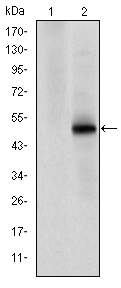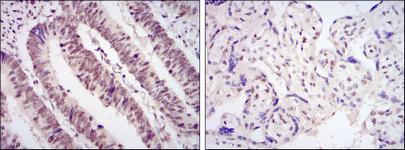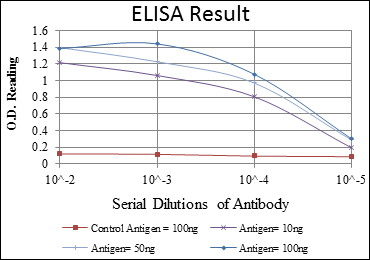Cdk9 Monoclonal Antibody
- Catalog No.:YM0147
- Applications:WB;IHC;IF;ELISA
- Reactivity:Human
- Target:
- Cdk9
- Fields:
- >>Viral life cycle - HIV-1;>>Transcriptional misregulation in cancer
- Gene Name:
- CDK9
- Protein Name:
- Cell division protein kinase 9
- Human Gene Id:
- 1025
- Human Swiss Prot No:
- P50750
- Mouse Swiss Prot No:
- Q99J95
- Immunogen:
- Purified recombinant fragment of human Cdk9 expressed in E. Coli.
- Specificity:
- Cdk9 Monoclonal Antibody detects endogenous levels of Cdk9 protein.
- Formulation:
- Liquid in PBS containing 50% glycerol, 0.5% BSA and 0.02% sodium azide.
- Source:
- Monoclonal, Mouse
- Dilution:
- WB 1:500 - 1:2000. IHC 1:200 - 1:1000. ELISA: 1:10000.. IF 1:50-200
- Purification:
- Affinity purification
- Storage Stability:
- -15°C to -25°C/1 year(Do not lower than -25°C)
- Other Name:
- CDK9;CDC2L4;TAK;Cyclin-dependent kinase 9;C-2K;Cell division cycle 2-like protein kinase 4;Cell division protein kinase 9;Serine/threonine-protein kinase PITALRE;Tat-associated kinase complex catalytic subunit
- Molecular Weight(Da):
- 43kD
- References:
- 1. J Biol Chem. 2008 Mar 21;283(12):7368-78.
2. Mol Cell Biol. 2008 Apr;28(7):2201-12.
- Background:
- cyclin dependent kinase 9(CDK9) Homo sapiens The protein encoded by this gene is a member of the cyclin-dependent protein kinase (CDK) family. CDK family members are highly similar to the gene products of S. cerevisiae cdc28, and S. pombe cdc2, and known as important cell cycle regulators. This kinase was found to be a component of the multiprotein complex TAK/P-TEFb, which is an elongation factor for RNA polymerase II-directed transcription and functions by phosphorylating the C-terminal domain of the largest subunit of RNA polymerase II. This protein forms a complex with and is regulated by its regulatory subunit cyclin T or cyclin K. HIV-1 Tat protein was found to interact with this protein and cyclin T, which suggested a possible involvement of this protein in AIDS. [provided by RefSeq, Jul 2008],
- Function:
- catalytic activity:ATP + [DNA-directed RNA polymerase] = ADP + [DNA-directed RNA polymerase] phosphate.,catalytic activity:ATP + a protein = ADP + a phosphoprotein.,function:Member of the cyclin-dependent kinase pair (CDK9/cyclin-T) complex, also called positive transcription elongation factor b (P-TEFb), which facilitates the transition from abortive to production elongation by phosphorylating the CTD (C-terminal domain) of the large subunit of RNA polymerase II (RNAP II), SUPT5H and RDBP. The CDK9/cyclin-K complex has also a kinase activity toward CTD of RNAP II and can substitute for P-TEFb in vitro.,similarity:Belongs to the protein kinase superfamily. CMGC Ser/Thr protein kinase family. CDC2/CDKX subfamily.,similarity:Contains 1 protein kinase domain.,subunit:Associates with CCNT1/cyclin-T1 to form P-TEFb. P-TEFb forms a complex with AFF4/AF5Q31. Also associates with CCNK/cyclin-K.
- Subcellular Location:
- Nucleus. Cytoplasm. Nucleus, PML body. Accumulates on chromatin in response to replication stress. Complexed with CCNT1 in nuclear speckles, but uncomplexed form in the cytoplasm. The translocation from nucleus to cytoplasm is XPO1/CRM1-dependent. Associates with PML body when acetylated.
- Expression:
- Ubiquitous.
- June 19-2018
- WESTERN IMMUNOBLOTTING PROTOCOL
- June 19-2018
- IMMUNOHISTOCHEMISTRY-PARAFFIN PROTOCOL
- June 19-2018
- IMMUNOFLUORESCENCE PROTOCOL
- September 08-2020
- FLOW-CYTOMEYRT-PROTOCOL
- May 20-2022
- Cell-Based ELISA│解您多样本WB检测之困扰
- July 13-2018
- CELL-BASED-ELISA-PROTOCOL-FOR-ACETYL-PROTEIN
- July 13-2018
- CELL-BASED-ELISA-PROTOCOL-FOR-PHOSPHO-PROTEIN
- July 13-2018
- Antibody-FAQs
- Products Images

- Western Blot analysis using Cdk9 Monoclonal Antibody against HEK293 (1) and CDK9-hIgGFc transfected HEK293 (2) cell lysate.

- Immunohistochemistry analysis of paraffin-embedded rectum cancer tissues (left) and placenta tissues (right) with DAB staining using Cdk9 Monoclonal Antibody.




